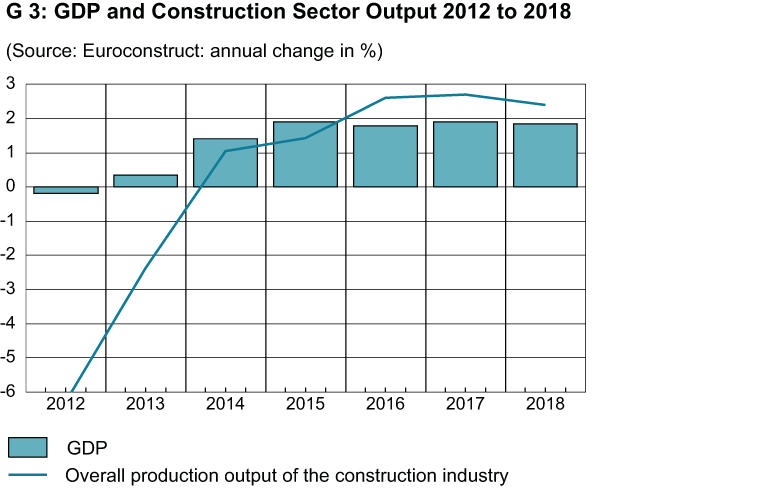Construction in Europe: Good Economic Prospects
The European construction sector has recovered from the crisis years and can hope for a continuation of the economic upswing.

The Euroconstruct network, within which the KOF is the Swiss representative, forecasts an overall real increase of investment in construction for its 19 European member countries of 2.6 per cent per year for the years 2016 to 2018. Based on stable overall economic development and low interest rates, development in new residential construction and civil engineering is particularly dynamic.
The economic environment in the 19 Euroconstruct countries, which are represented by the national research institutes, is stable. In 2015 real gross domestic product (GDP) increased by 1.9 per cent (see G3). For the first time in eight years, all countries posted an increase in economic activity. For the 2016-2018 period, the Euroconstruct institutes are forecasting this development to continue with average real annual growth of 1.9 per cent. This will be fuelled by private consumer spending as well as the labour market. Growth in public spending is projected to grow at a more modest rate of 0.8 per cent in 2017 and 2018. As previously, inflation will remain low. The Euroconstruct institutes have however revised the inflation forecast upwards due to the increase in the price of oil compared to the last forecast (December 2015).
The recovery of the European construction industry continued into 2015 with a 1.4 per cent increase in investment in construction. The construction sector benefits from low interest rates, an increase in real disposable household income and stabilised residential construction. Euroconstruct is forecasting an increase in aggregate construction activity by 2.6 per cent in 2016, 2.7 per cent in 2017 and 2.4 per cent in 2018.
However, development is not uniform throughout the member countries. In particular the Eastern European and Scandinavian countries along with Ireland are expecting dynamic development over the forecasting period. The largest contribution to economic growth over the coming years will be provided by France, which after years of recession is expecting an upswing in construction activity.
Upswing supported by new residential construction and civil engineering
This year, residential construction is supporting the European construction sector with projected growth of 3.1 per cent (see G4). There is positive development in particular in the area of new residential construction. In 2016 a total of 1.54 million new homes are expected to be completed, which represents an increase of 9.1 per cent compared to the low-point in 2013. An important driver for this has been the influx of refugees, in particular in Norway and Germany. Refurbishment activity accounts for around 60 per cent of residential construction and is developing stably, albeit with less dynamism than new-build construction.
Non-residential construction, which varies strongly in line with the overall economic situation, is forecast to grow by an average of 2.3 per cent per year over the period 2016-2018. Ireland is expecting extraordinarily high construction activity in this segment in order to make up for the investment shortfall over the last few years. In Hungary, EU funds will support investment in the non-residential sector from 2014 until 2020. In particular the construction of offices and storage facilities is contributing to the upswing, whilst educational building is posting the weakest growth.
Public sector austerity measures as a result of the European debt crisis have kept a lid on civil engineering projects for a long time. In 2014 this segment recovered with growth of 0.8 per cent, and has been expanding further since 2015 (2.9 per cent). Growth is expected to slow in 2016, although Euroconstruct is expecting an economic upswing in 2017 (3 per cent) and 2018 (3.8 per cent). This development is broadly supported throughout the European countries, with the exception of Finland, Portugal and Spain. Despite the financial restrictions on public spending, investment requirements associated with the influx of refugees (for example in Germany), the current inadequate state of infrastructure and positive economic growth prospects have contributed to dynamic development. Norway and Switzerland occupy the top positions in terms of civil engineering investment per capita.
The 81st Euroconstruct Conference was held in Dublin in the middle of June 2016. Euroconstruct is an association of European economic research institutes within the construction sector. Forecasts are presented twice each year concerning developments in the construction sector within the individual member countries. The KOF is the Swiss representative. Further information is available here
Contact
No database information available

